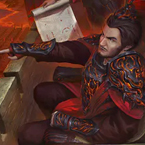Let us consider what any given deck’s game plan may look like in Flesh and Blood.
A game plan is the road map that every well constructed deck has to lead them to victory. Decks that are aggressive aim to pressure the opponent’s life total and hand through overwhelming offensive capabilities, while blocking minimally. Decks that are more setup-oriented are methodical about their defenses, only taking damage when absolutely necessary to play out their core card combinations or items.
If game plans are a generalized road map, play patterns are the specific directions and points of interest. Katsu pitches a blue card most turns to attack with a Kodachi or two, and follow up attacks to threaten both the Mask of Momentum triggers and his hero ability trigger. Control Dash blocks the bulk of the opponent’s attacks and pitches a blue to shoot the Teklo Plasma Pistol. The Redline Lightning Briar deck (also known as "Cheerios"), piloted by US National Champion Tariq Patel, plays as many 0-resource cost cards as possible each turn, to attack multiple times, each attack threatening on-hit effects and passing critical breakpoints.
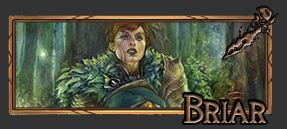
Briar is dominating the Classic Constructed format because she presents one of the most proactive game plans of any deck, and excels at executing it on a turn-to-turn basis. Her primary game plan is to be the aggressor- low to the ground, constantly pressuring the opponent. She wins the game off both immediate tempo and incremental gain. She plays well into most matchups or archetypes with some adjustments, but doesn’t give up either her consistency or explosiveness. Her game plan is one with both an incredibly high floor and ceiling. And at the core of this game plan are the synergies between her cards and abilities.
Attacking on Curve
Before we explore the idea of synergy in detail, let’s establish what it means for attacks to be on curve. Attacks generally follow a “curve”, or “rate”, for cost versus power. This curve is further modified by the pitch value of the card, but as we're focusing on attacks, we'll be discussing this as it corresponds with red (1) pitch values.
Listed below are some corresponding ‘vanilla’ generic attacks.
- Raging Onslaught - 7 power for 3 resources
- Brutal Assault - 6 power for 2 resources
- Back Alley Breakline* - 5 power for 1 resource
- Wounding Blow - 4 power for 0 resource
*nearest equivalent to a no-text generic
Attack action cards can also have additional upsides, downsides, or costs associated with them- often by sacrificing a point of defense. Some attacks will have their base power reduced as a trade-off for the power of their other abilities. We can also compare generic cards to class cards. Class-limited attack action cards often have an additional upside associated with the class or talent mechanics, while still blocking 3. (Curiously, there is no generic attack with 5 power for 1 resource with no ability and 3 defense- which is why we had to use Back Alley Breakline as our example.)
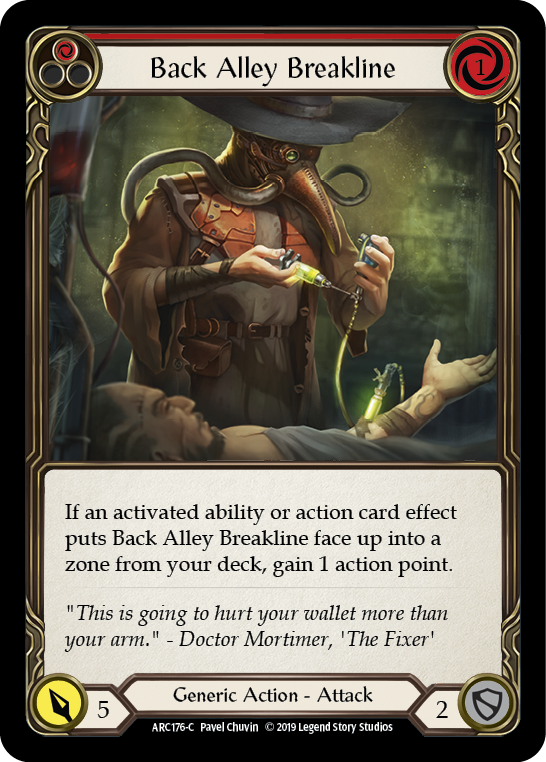
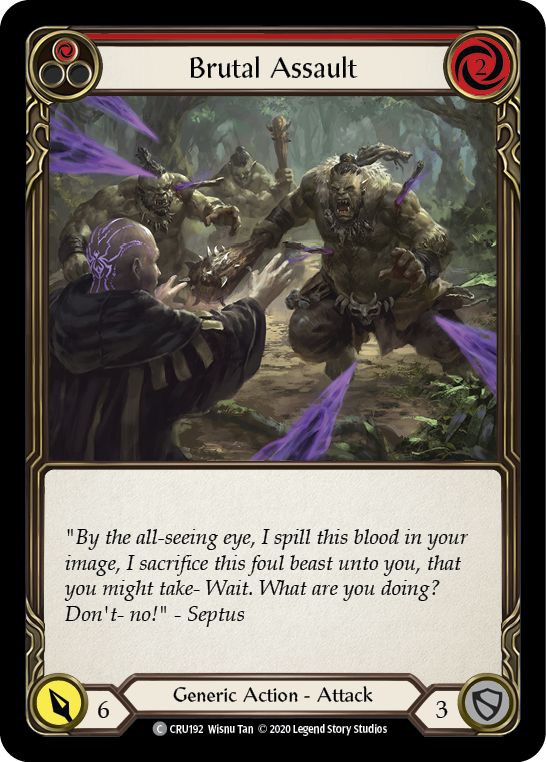
A general concept in Flesh and Blood is card efficiency. Raging Onslaught and other ‘vanilla’ or ‘on-curve’ Attack Actions at the breakpoints of 4 power and 7 power can often be quite efficient, in that they will trade well for the opponent’s cards. Breakpoints are defined as the critical number that allows for favorable exchanges. Wounding Blow or other 4 power 0 cost cards will trade favorably with an opponent’s card that blocks for 3. Both cards are consumed, but the attacker comes out ahead to the tune of 1 life.
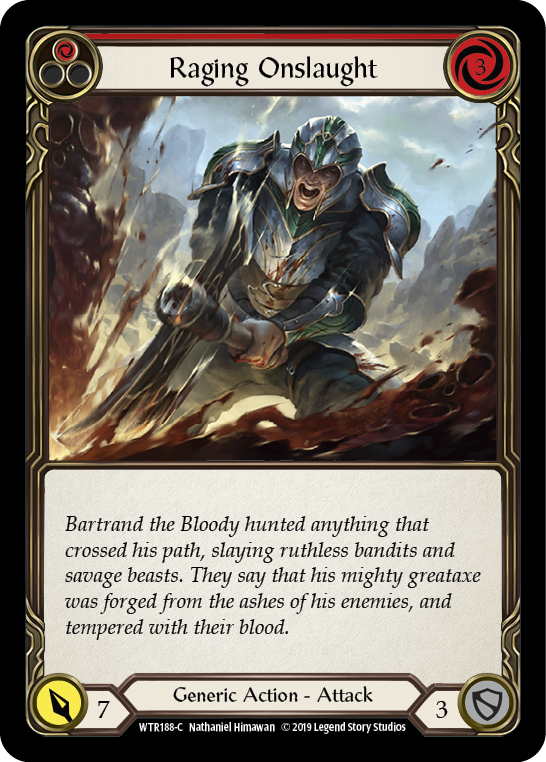
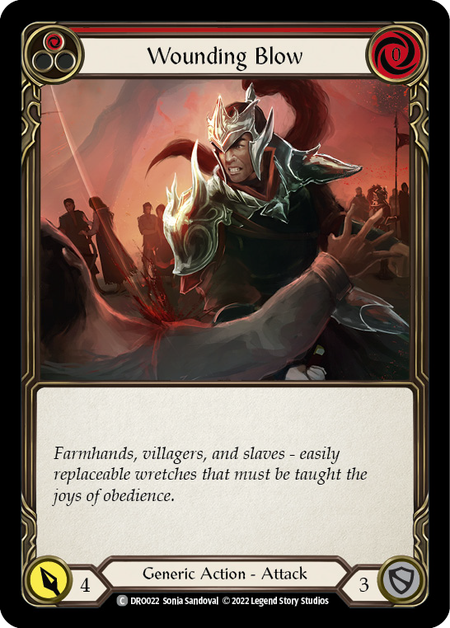
Similarly, Raging Onslaught can be viewed as trading two cards for two cards- but in some ways, it's trading one card for two cards. In the context of turn-to-turn tempo, this can be assessed as a trade of two cards- one card to pitch and one card to play, for the opponent’s two cards used to block. The attacker comes out ahead in the exchange to the tune of one damage that is not blocked by the opponent’s vanilla 3 defense cards. But, in a game that goes to fatigue, one card is used (the attack) and the other pitched card is retained within the deck, whereas the opponent’s two cards that are used to block are both put in the graveyard. Card efficiency and breakpoints can be quite important in the assessment of the power level of cards or decks.
Given the above, why are decks with full copies of Raging Onslaught or Wounding Blow not making the top tables at competitive events? The answer is quite simple - these cards lack cohesion, or synergy. While they may be reasonably costed, on curve, and at times they may even be card efficient, they just cannot keep up with other card combinations that prove to be greater than the sum of their parts.
Synergy- Yet Another Buzz Word
On the face of it, a card like Autumn's Touch is an adequate but otherwise uninteresting card in Tales of Aria. It is “On Curve” with 7 Power for 3 resources in red, which is quite reasonable; and it blocks for 3, which cannot be understated. But it has no additional ability whatsoever. What cards like Autumn’s Touch, Heaven’s Claws and Winter’s Grasp do have is the sneakily relevant text at the bottom of the card: they are element cards.
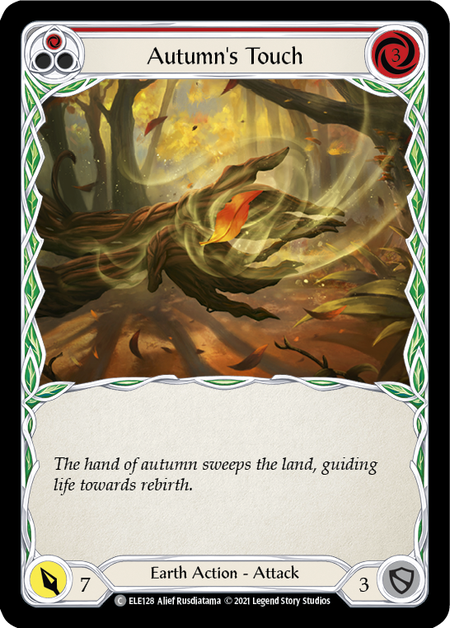
In the context of FAB, what exactly is synergy? Synergy is defined here as the ability of multiple cards to come together and provide a much greater impact than any of the cards played individually. Synergy between specific cards and synergy throughout an entire deck is what separates a good idea from a good deck.
Let’s make the distinction between “Inorganic Synergy” and “Organic Synergy”.
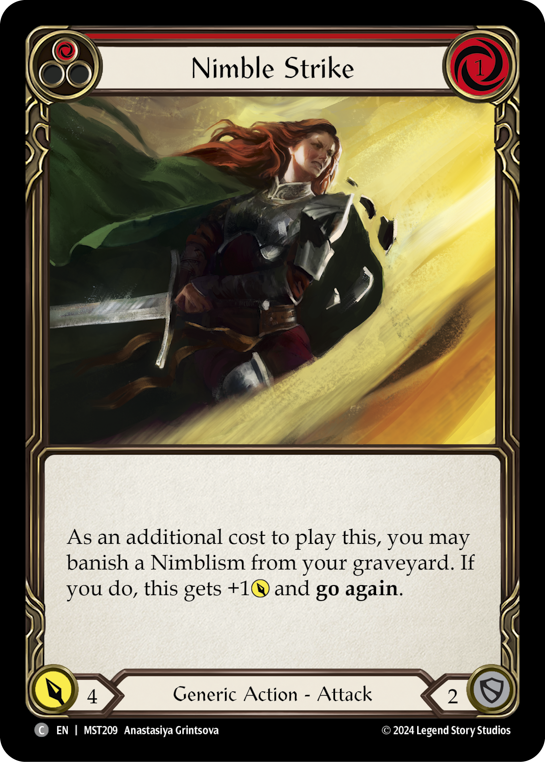

Inorganic Synergy exists in the form of specific card combinations. A great generic example is Nimble Strike and Nimblism. Nimble Strike is more powerful when you can precede it with Nimblism. These synergies are explicitly created by LSS- if you fulfill a specific requirement, the power level of the cards are increased.
For Briar, this applies to cards with the Fusion condition. Elemental cards with a Fuse condition are more powerful than a similar card only specifically when you are able to Fuse them. As such, you are highly incentivized in deckbuilding to be able to Fuse these cards for their more powerful effects. Conversely, when not Fused, these cards may be much worse than their comparable generics. This form of synergy generally restricts deckbuilding choice as a trade-off for raw power level.
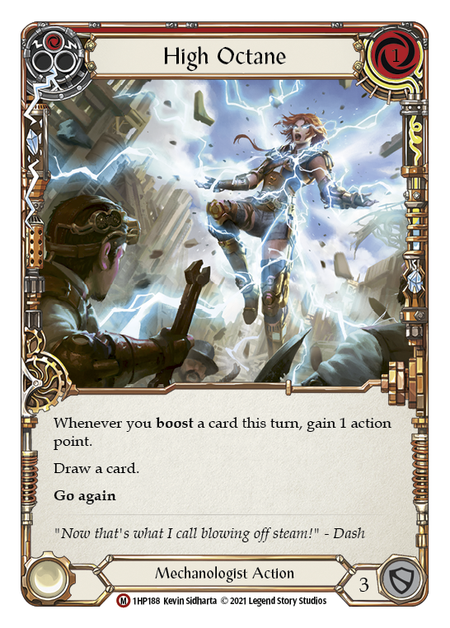
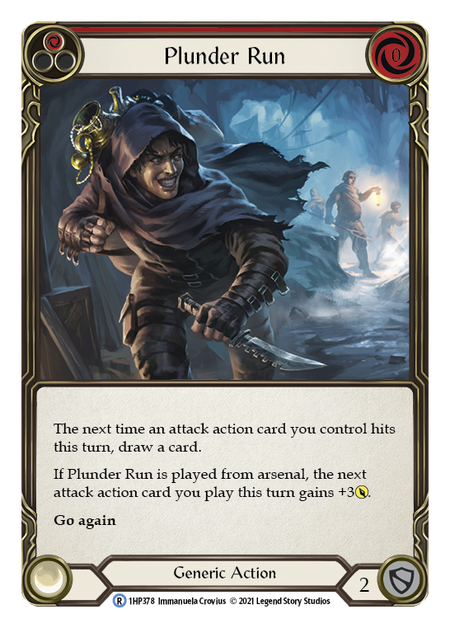
Organic Synergy is a more nebulous concept that exists in the form of general card combinations between types of cards. One example of this may be the play pattern of playing Plunder Run, followed by multiple Attack Action cards with Go Again, with each attack threatening an on-hit trigger to draw a card. Another example might be the ability for Mechanologists to use the extra action points gained from High Octane to play out extra items or Spark of Genius. Runeblade heroes and cards often gain additional value or effects from playing Non-Attack Actions, therefore there is strong synergy between Non-Attack Actions that draw cards and the rest of their toolkit.
Organic synergies are not always designed for a specific purpose, but rather exist as a natural way in which cards and abilities interact. It is almost certain that LSS has tested many of these card interactions, but the best deckbuilders can identify these inherent synergies and construct their deck around playing out these high synergy sequences that result in gaining an incremental advantage over other decks and players.
The important point here: when a deck reaches a critical mass of these core synergies, whether Inorganic or Organic, it is able to consistently carry out a more impactful game plan than a deck playing vanilla on-rate cards.
This perhaps gives some insight as to why we should be excited about cards like Autumn’s Touch. Autumn’s Touch and other key element-typed cards like it can fulfill both Organic and Inorganic Synergy roles within a deck.
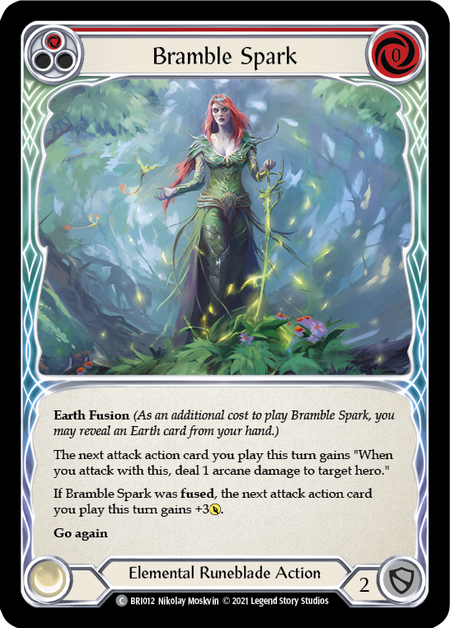
As part of the fuse cost of a card like Bramble Spark, Autumn’s Touch fulfills the requirement to power Bramble Spark up to an above-rate buff of 3 power plus one arcane damage, as compared to Nimblism or other similar effects which provide a 3 power buff. In Earth Briar decks, Autumn’s Touch also simultaneously fills the play pattern of attacking with a large attack every turn, threatening the on-hit effect of creating an Embodiment of Earth.

In Lightning Briar decks, Lightning Surge is a 4 power attack for 0 resource cost, can fuse other Lightning cards, and even has additional upside when played from Arsenal. Weave Lightning is a Nimblism for many of the attacks in the deck, but can meet the specific criteria for Fusion, while potentially also providing an additional action point on its own- and can contribute towards an Embodiment of Lightning!
When element-typed cards are able to be relevant as a card on their own without being a detriment- and also fulfill multiple roles- they become very good inclusions in building a deck.
A key factor in constructing a deck around synergies is opportunity cost. What occurs if cards with Inorganic Synergy are unable to meet their specific requirements? They are severely underpowered or have minimal impact. So generally we want to ensure that we can always fulfill their requirements by playing a sufficient number of cards to fulfill those conditions- in this instance, element-typed cards to fuse. However, as we dig deeper into the available card pool for element cards, we need to be cognizant that we should try to only play the cards that fit into our general game plan.
Let me repeat that, maybe with a quote format this time for emphasis:
We should try to only play cards that fit into our game plan.
A poor element card in the deck is worse than no element card at all. The opportunity cost of playing low impact- or even actively bad- element cards undermines our game plan, especially when the alternative may have been additional slots within the deck for powerful generic cards. Simply put, this is the dance we do in deckbuilding to maintain adequate ratios in the deck by including cards to fulfill Inorganic Synergy conditions, while maintaining a cohesive game plan and playing card combinations with innate Organic Synergy.
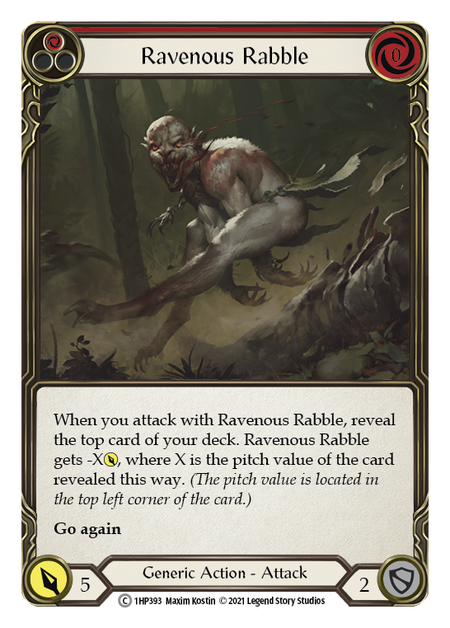


The Lightning Briar deck that's currently warping the CC format around itself recognizes this fact, and in fact prioritizes the Organic Synergies available to it in the form of 0-cost generic attacks and non-attack actions: Nimblism, Plunder Run, Snatch, Scar for a Scar, and Ravenous Rabble. When you overload on these cards, you’re all but guaranteed to draw hand after hand of high synergy cards.
The Road Up Mount Heroic
To come full circle, what is Lightning Briar’s game plan? Simply put, Lightning Briar is an aggressive deck that wants to assert itself as the driver of tempo within the game. It wants to stay low to the ground, and apply constant pressure with multiple attacks per turn. Each attack will also meet critical breakpoints, which not only demand inefficient blocks or armor from the opponent, but can also generate Embodiment of Earth tokens to enhance her ability to block. With each attack, Briar presents a no-win choice to the opponent where the outcome is that she benefits from any choice the opponent makes: an opponent that takes damage to play towards a big pivot turn will find themself staring down multiple Embodiment of Earth tokens in play, in addition to the 6 block from her armor alone.
Furthermore, the Lightning deck wants to maximize the use of her cards. She wants to play out all of her cards in sequence for maximum benefit. Rarely will she have to actually pay resources for her cards or abilities. This is one way in which Briar gains an edge over her opponents: every single turn she can play out four cards for their printed effect, compared to decks that must pitch at least one card, and play out the remaining three cards. For Briar, gaining one to three resources is a lot less effective than attacking for a critical breakpoint of 4, or contributing towards gaining an extra action point. It matters less if some cards are slightly inefficient- although few in the deck are- if you are simply playing one additional card every turn compared to your opponents.
The overall game plan. and both desired and effective play patterns, should inform deck building decisions. By maximizing synergies, Lightning Briar can play exceptionally well through the opponent's disruption. She can play out perfectly functional hands without the Lightning-typed cards required to fuse.
There’s no way around it: the new heroes in Tales of Aria love playing with five card hands. Perhaps even more so than her compatriots, Briar is capable of some absolutely ridiculous sequences when she has the opportunity to play out five card hands. By maximizing the benefits of Inorganic and Organic Synergies in deckbuilding, we maximize the benefits and likelihood of playing synergistic cards in combination.
The Future of Lightning Briar
Attacking Lightning Briar has proven to be challenging, but Ice Lexi has certainly shown that it is capable of holding its ground when played masterfully. Other approaches have had varying levels of success, with Oldhim builds being refined as the Classic Constructed format finds its legs. The nature of building a deck centered around playing cards with no resource cost results in a deck vulnerable to resource tax effects.
The ongoing evolution of Briar decks will be interesting to watch as the meta adapts around her. A challenger to the Redliner Lightning deck has appeared in the form of a Mount Heroic Lightning deck. The new variant has achieved several Nationals wins (Germany, Poland) and Top 8 appearances (Canada, Austria, Denmark, Netherlands). This new variant pushes the boundaries of balancing both Organic and Inorganic Synergies, and really shows how creative and methodical deckbuilding can produce truly frightening results.
It is likely that the inherent power level of Briar’s abilities and the further adjustments deck builders make to create specific game plans against the Ice decks will keep her at the top of the heap until Everfest shakes up the meta even further.
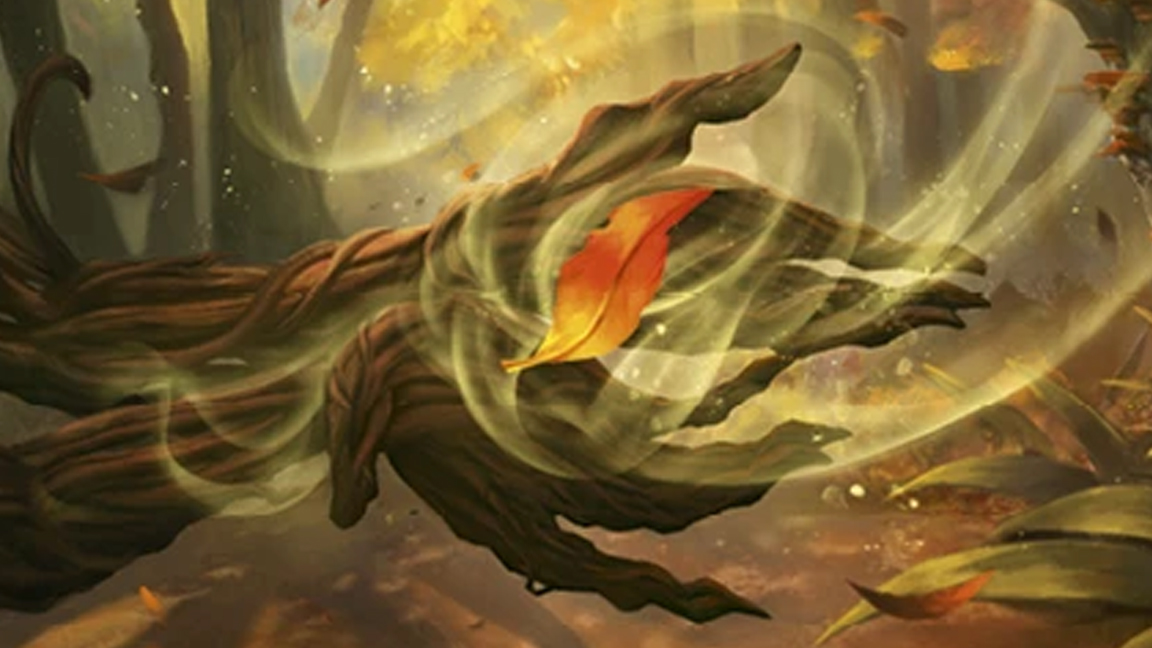
And perhaps one day, I'll expound upon the Autumn's Touch manifesto I began above. But that's a strategy for another season...




